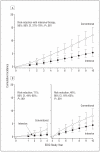Prolonged effect of intensive therapy on the risk of retinopathy complications in patients with type 1 diabetes mellitus: 10 years after the Diabetes Control and Complications Trial
- PMID: 19064853
- PMCID: PMC2663518
- DOI: 10.1001/archopht.126.12.1707
Prolonged effect of intensive therapy on the risk of retinopathy complications in patients with type 1 diabetes mellitus: 10 years after the Diabetes Control and Complications Trial
Abstract
Objective: To examine the persistence of the original treatment effects 10 years after the Diabetes Control and Complications Trial (DCCT) in the follow-up Epidemiology of Diabetes Interventions and Complications (EDIC) study. In the DCCT, intensive therapy aimed at near-normal glycemia reduced the risk of microvascular complications of type 1 diabetes mellitus compared with conventional therapy.
Methods: Retinopathy was evaluated by fundus photography in 1211 subjects at EDIC year 10. Further 3-step progression on the Early Treatment Diabetic Retinopathy Study scale from DCCT closeout was the primary outcome.
Results: After 10 years of EDIC follow-up, there was no significant difference in mean glycated hemoglobin levels (8.07% vs 7.98%) between the original treatment groups. Nevertheless, compared with the former conventional treatment group, the former intensive group had significantly lower incidences from DCCT close of further retinopathy progression and proliferative retinopathy or worse (hazard reductions, 53%-56%; P < .001). The risk (hazard) reductions at 10 years of EDIC were attenuated compared with the 70% to 71% over the first 4 years of EDIC (P < .001). The persistent beneficial effects of former intensive therapy were largely explained by the difference in glycated hemoglobin levels during DCCT.
Conclusion: The persistent difference in diabetic retinopathy between former intensive and conventional therapy ("metabolic memory") continues for at least 10 years but may be waning.
Trial registration: (clinicaltrials.gov) Identifiers: NCT00360815 and NCT00360893.
Figures



Comment in
-
Metabolic memory in diabetes is true long-term memory.Arch Ophthalmol. 2009 Mar;127(3):330-1. doi: 10.1001/archophthalmol.2008.607. Arch Ophthalmol. 2009. PMID: 19273799 No abstract available.
References
-
- The effect of intensive therapy of diabetes on the development and progression of long-term complications in insulin-dependent diabetes mellitus: the Diabetes Control and Complications Trial Research Group. N Engl J Med. 1993;329(14):977–986. - PubMed
-
- Early Treatment Diabetic Retinopathy Study Research Group Fundus photographic risk factors for progression of diabetic retinopathy: ETDRS report number 12. Ophthalmology. 1991;98(5suppl):823–833. - PubMed
-
- The effect of diabetes therapy on the progression of diabetic retinopathy in insulin-dependent diabetes mellitus: the Diabetes Control and Complications Trial. Arch Ophthalmol. 1995;113(1):36–51. - PubMed

